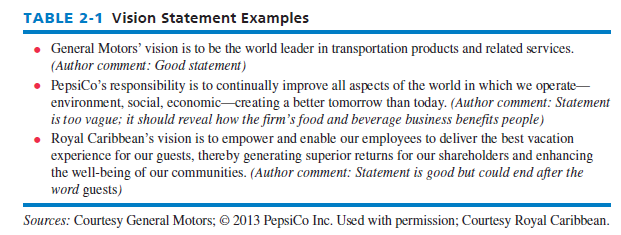It is especially important for managers and executives in any organization to agree on the basic vision that the firm strives to achieve in the long term. A vision statement should answer the basic question, “What do we want to become?” A clear vision provides the foundation for developing a comprehensive mission statement. Many organizations have both a vision and mission statement, but the vision statement should be established first and foremost. The vision statement should be short, preferably one sentence, and as many managers as possible should have input into developing the statement. Where there is no vision, the people perish (Proverbs 29:18).
For many, if not most, corporations, profit rather than mission or vision is the primary motivator. But profit alone is not enough to motivate people. Profit is perceived negatively by many stakeholders of a firm. For example, employees may see profit as something that they earn and management then uses and even gives away to shareholders. Although this perception is undesired and disturbing to management, it clearly indicates that both profit and vision are needed to motivate a workforce effectively.
When employees and managers together shape or fashion the vision and mission statements for a firm, the resultant documents can reflect the personal visions that managers and employees have in their hearts and minds about their own futures. Shared vision creates a commonality of interests that can lift workers out of the monotony of daily work and put them into a new world of opportunity and challenge.
Although typically a single sentence, vision statements need to be written from a customer perspective. For example, eBay’s vision is “To provide a global trading platform where practically anyone can trade practically anything.” Vision statements need to do more than identify the product/service a firm offers. The old Ford Motor Company vision, for example, was product- oriented: “To make the automobile accessible to every American,” but today Ford has a more effective customer-oriented vision statement: “To provide personal mobility for people around the world.” Examples of vision statements are provided in Table 2-1.
Vision Statement Analysis
At a minimum, a vision statement should reveal the type of business the firm engages. For example, to have a vision that says, “to become the best retailing firm in the USA” is much too broad, because that firm could be selling anything from boats to bunnies. Notice here how Starbucks’ vision statement is improved.
Starbucks Vision Statement (paraphrased)
Starbucks strives to be the premier roaster and retailer of specialty coffee globally.
Starbucks “Improved” Vision Statement
Starbucks’ vision is to be the most well-known, specialty coffee, tea, and pastry restaurant in the world, offering sincere customer service, a welcoming atmosphere, and unequaled quality.
Author Comments
- The first vision statement does not state what the company wants to become. Nor does it acknowledge the firm’s movement into specialty tea offerings. It is not as customer- oriented as needed.
- The improved vision statement reveals the company’s aspirations for the future and acknowledges that upscale tea and pastries complement their premium coffee offerings.

Source: David Fred, David Forest (2016), Strategic Management: A Competitive Advantage Approach, Concepts and Cases, Pearson (16th Edition).

17 May 2021
17 May 2021
18 May 2021
18 May 2021
17 May 2021
17 May 2021